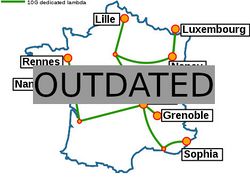Grid5000:Home
|
Grid'5000 is a large-scale and versatile testbed for experiment-driven research in all areas of computer science, with a focus on parallel and distributed computing including Cloud, HPC and Big Data. Key features:
Older documents:
|
Random pick of publications
Five random publications that benefited from Grid'5000 (at least 2925 overall):
- Georges da Costa, Amina Guermouche. Measurement methods sheet, WG6 Exa-Soft. Université de Toulouse; Université de bordeaux. 2025. hal-05272179 view on HAL pdf
- Alexandre Bonvoisin, Clément Quinton, Romain Rouvoy. Understanding the Performance-Energy Tradeoffs of Object-Relational Mapping Frameworks. SANER'24 - 31th IEEE International Conference on Software Analysis, Evolution and Reengineering, Mar 2024, Rovaniemi, Finland. pp.11. hal-04401643v2 view on HAL pdf
- Dorian Goepp, Samuel Brun, Quentin Guilloteau, Olivier Richard. Un prototype de cache de métadonnées pour le passage à l'échelle de NixOS-Compose. COMPAS 2024 - Conférence francophone d'informatique en Parallélisme, Architecture et Système, Jul 2024, Nantes, France. pp.1-8. hal-04632952 view on HAL pdf
- Alix Jeannerot. Uplink Resource Allocation Methods for Next Generation Wireless Networks. Networking and Internet Architecture cs.NI. INSA lyon, 2024. English. NNT : . tel-04816916v2 view on HAL pdf
- Rosa Pagano. Adaptive control of HPC clusters for server overload avoidance. Distributed, Parallel, and Cluster Computing cs.DC. 2023. hal-04390558 view on HAL pdf
Latest news
Failed to load RSS feed from https://www.grid5000.fr/mediawiki/index.php?title=News&action=feed&feed=atom: Error parsing XML for RSS
Grid'5000 sites
Current funding
As from June 2008, Inria is the main contributor to Grid'5000 funding.
INRIA |
CNRS |
UniversitiesUniversité Grenoble Alpes, Grenoble INP |
Regional councilsAquitaine |


